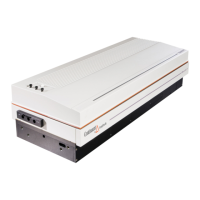C
3-68
996-0255 rev. b
Precision II Operation and Maintenance Manual
Trigger Circuit
The trigger PCBA (see schematics p. 3-76 & 77) contains logic circuitry to
monitor for simmer or non-simmer ( U5 & U6). Output signals indicate
"POWER ON" and simmer/non-simmer operation, (J4). The front panel
"Delay Adj" adjusts the firing of the flashlamps and the delay (50-550 µs)
of the J4 CU sync out found on the rear panel. The +750 V power supply
CAUTION:
Do NOT interchange J4 and J5. The output of J4 must not be used
to trigger other CB630C’s!
will charge C13-C16. The delay signal (U3, U6, Q12) will trigger Q2
through Q1. This turns on the SCR Q2 by pulling the gate positive.
Capacitors C13 through C16 have been previously charged by the +750
volt supply. Turning on Q2, in effect, connects these capacitors directly
across the primary coil of the trigger transformer. This induces a 17 kV
spike in the secondary coil.
However, the flashlamp will ionize before this voltage is reached. The
ionized flashlamp discharges the main capacitor to cause the high inten-
sity light flash.
Conduction path for the high current discharge is from the capacitor
through the saturated transformer T2, then through a coaxial cable to the
flashlamp. Return current is carried through the cable shields back to the
capacitor bank chassis.
4. Connections and Signals
The capacitor banks get their high voltage from the power unit (see the
wiring diagram pages 3-72 & 79). The head cable of the first capacitor
bank leads to the oscillator head and its flashlamps.
The second capacitor bank has its head cable attached to the amplifier
head to power its flashlamps.
The power lines can be seen on the wiring diagram. All grounding lugs
of the electronics in the rack are connected to each other and the laser
table. Each unit is grounded through the power cable to the power line
ground.
The CB600C series are all one channel units. Their total capacitances are
as follows:
CB630C 18 µF
CB631C 30 µF
CB634C 30 µF & 18 µF

